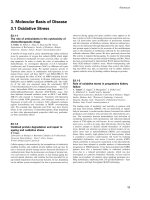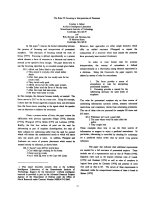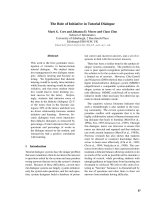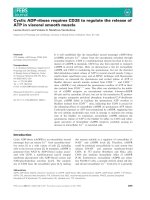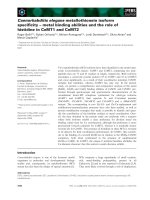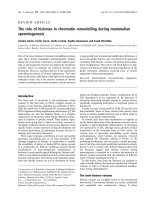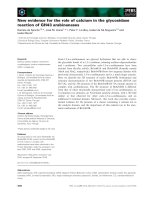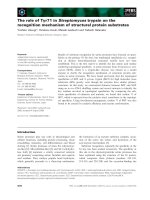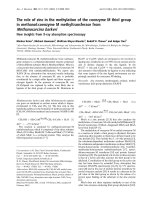THE ROLE OF SWI/SNF IN REGULATING SMOOTH MUSCLE DIFFERENTIATION
Bạn đang xem bản rút gọn của tài liệu. Xem và tải ngay bản đầy đủ của tài liệu tại đây (15.87 MB, 164 trang )
THE ROLE OF SWI/SNF IN REGULATING SMOOTH MUSCLE
DIFFERENTIATION
Min Zhang
Submitted to the faculty of the University Graduate School
in partial fulfillment of the requirements
for the degree
Doctor of Philosophy
in the Department of Cellular and Integrative Physiology,
Indiana University
October 2009
ii
Accepted by the Faculty of Indiana University, in partial
fulfillment of the requirements for the degree of Doctor of Philosophy.
B.Paul Herring, Ph.D, Chair
Anthony B. Firulli, Ph.D
Doctoral Committee
Fredrick M. Pavalko, Ph.D
September 8
th
, 2009
Simon J. Rhodes, Ph.D
iii
This thesis is dedicated to the memory of my beloved father Jiagen Zhang and
my grandparents Cijing Chen and Qinchen Zhang.
iv
Acknowledgements
I would like to thank my advisor Dr. B. Paul Herring from the bottom of my heart. I
am extremely lucky to have been one of his students. I have received fully
support from Dr. Herring throughout my whole Ph.D program. Without his
encouragement, guidance and patience, I could not finish my thesis project and
dissertation.
I sincerely appreciate the kind guidance and the thoughtful suggestions from my
committee members: Dr. Anthony B. Firulli, Dr. Fredrick M. Pavalko and Dr.
Simon J. Rhodes.
I would like to thank my current and former colleagues in Herring lab: Dr. Jiliang
(Leo) Zhou, Hong Fang, Ketrija Touw, April Hoggatt, Meng Chen, Rebekah
Jones, Dr. Feng Yin and Dr. Omar El-Mounayri. I have got lots of help from them
and I really enjoy working with them. I want to give my special thanks to Dr. Zhou
for his selfless support. I also want to thank my colleagues from Gallagher lab:
Dr. Patricia J. Gallagher, Dr. Rui Duan, Dr. Liguo Zhang, Emily Blue and Ryan
Widau, for their friendship and help.
I would like to thank my parents: Jiagen Zhang and Ping Chen, and my sister and
brother in law: Yan Zhang and Zhiguang Yu, who have given me their endless
love. Last but not least, I would like to thank my husband Sunyong Tang for his
understanding and love from the bottom of my heart.
v
Abstract
Min Zhang
THE ROLE OF SWI/SNF IN REGULATING SMOOTH MUSCLE
DIFFERENTIATION
There are many clinical diseases involving abnormal differentiation of smooth
muscle, such as atherosclerosis, hypertension and asthma. In these diseases,
one important pathological process is the disruption of the balance between
differentiation and proliferation of smooth muscle cells. Serum Response Factor
(SRF) has been shown to be a key regulator of smooth muscle differentiation,
proliferation and migration through its interaction with various accessory proteins.
Myocardin Related Transcrition Factors (MRTFs) are important co-activators of
SRF that induce smooth muscle differentiation. Elucidating the mechanism of
how MRTFs and SRF discriminate between genes required to regulate smooth
muscle differentiation and those regulating proliferation will be a significant step
toward finding a cure for these diseases. We hypothesized that SWI/SNF ATP-
dependent chromatin remodeling complexes, containing Brg1 and Brm, may play
a role in this process. Results from western blotting and quantitative reverse
transcription - polymerase chain reaction (qRT-PCR) analysis demonstrated that
expression of dominant negative Brg1 or knockdown of Brg1 with silence
ribonucleic acid (siRNA) attenuated expression of SRF/MRTF dependent smooth
muscle-specific genes in primary cultures of smooth muscle cells.
vi
Immunoprecipitation assays revealed that Brg1, SRF and MRTFs form a
complex in vivo and that Brg1 directly binds MRTFs, but not SRF, in vitro.
Results from chromatin immunoprecipitation assays demonstrated that dominant
negative Brg1 significantly attenuated SRF binding and the ability of MRTFs to
increase SRF binding to the promoters of smooth muscle-specific genes, but not
proliferation-related early response genes. The above data suggest that
Brg1/Brm containing SWI/SNF complexes play a critical role in differentially
regulating expression of SRF/MRTF-dependent genes through controlling the
accessibility of SRF/MRTF to their target gene promoters. To examine the role of
SWI/SNF in smooth muscle cells in vivo, we have generated mice harboring a
smooth muscle-specific knockout of Brg1. Preliminary analysis of these mice
revealed defects in gastrointestinal (GI) development, including a significantly
shorter gut in Brg1 knockout mice. These data suggest that Brg1-containing
SWI/SNF complexes play an important role in the development of the GI tract.
B.Paul Herring, Ph.D, Chair
vii
Table of Contents
List of Tables viii
List of Figures ix
List of Abbreviations xii
Chapter I: Introduction
A. Smooth muscle development 1
B. Smooth muscle diseases 2
C. Serum Response Factor and smooth muscle development and
diseases. 5
D. Myocardin Related Transcription Factor A and smooth muscle
development 7
E. Brg1/Brm ATP-dependent chromatin remodeling enzymes. 9
F. Hypothesis 11
Chapter II: A novel role of Brg1 in the regulation of SRF/MRTFA-dependent
smooth muscle-specific gene expression. 16
Chapter III: The SWI/SNF chromatin remodeling complex regulates myocardin-
induced smooth muscle-specific gene expression 49
Chapter IV: The role of Brg1/Brm in smooth muscle differentiation in vivo 86
Chapter V: Understanding the GI phenotypes of smooth muscle-specific
Brg1 KO and Brg1/Brm double KO mice. 105
Chapter VI: Discussion and Future Studies 133
References 138
Curriculum Vitae
viii
List of Tables
Table 1 130
Table 2 131
Table 3 132
ix
List of Figures
Figure 1. The gradient expression of transcription factors in GI tracts
development. 12
Figure 2. Three important determinants of SMC differentiation and phenotypic
changes. 13
Figure 3. SRF/MRTFs target genes. 14
Figure 4. The structural domains and binding partners of MRTFs family. 15
Figure 5. The expression of DN-Brg1 in 3T3 fibroblasts interferes with the
induction of endogenous SRF-dependent smooth muscle-specific genes by
MRTFA. 37
Figure 6. The expression of DN-Brg1 in 3T3 fibroblasts interferes with the
induction of endogenous SRF-dependent smooth muscle-specific proteins by
MRTFA. 39
Figure 7. MRTFA cannot induce smooth muscle-specific gene expression in
SW13 cells that lack Brg1/Brm1. 40
Figure 8. DN-Brg1 interferes with smooth muscle gene expression in primary
smooth muscle cells. 41
Figure 9. Brg1 forms a complex with SRF and MRTFA in vivo. 42
Figure 10. Brg1 binds MRTFA but not SRF in vitro. 44
Figure 11. DN-Brg1 attenuates the ability of MRTFA to increase SRF binding
to the promoters of smooth muscle-specific genes. 45
Figure 12. Proposed model describing the regulation of MRTFA/SRF activity
by Brg1. 47
x
Figure 13. Effects of depletion Brg1 or Brm on expression of endogenous
smooth muscle-specific genes. 73
Figure 14. DN-Brg1 abrogates the induction of smooth muscle-specific genes
by myocardin. 74
Figure 15. Dominant negative Brg1 blocks the induction of endogenous smooth
muscle-specific genes by myocardin. 76
Figure 16. Re-introduction of wild type Brg1 or Brm, but not an ATPase
deficient mutant, into SW13 cells restores myocardin’s ability to induce
expression of smooth muscle-specific genes. 78
Figure 17. DN-Brg1 blocks the ability of myocardin to increase SRF binding to
the promoters of smooth muscle-specific genes within chromatin. 80
Figure 18. Myocardin, SRF and Brg1 form a complex in vivo and Brg1 binds
directly to myocardin in vitro. 82
Figure 19. Brg1 ATPase domain binds to the amino-terminus of myocardin. 84
Figure 20. Generation of smooth muscle-specific Brg1 knockout mice. 97
Figure 21. Contractile proteins are not decreased in Brg1 KO mice. 99
Figure 22. Contractile proteins are not decreased in Brm null mice. 101
Figure 23. Generating Smooth muscle-specific Brg1 KO on Brm null
background. 102
Figure 24. Contractile proteins are decreased in Brg1/Brm double KO mice. 103
Figure 25. The contractility of the colon from Brg1 knockout mice is
remarkably impaired. 119
xi
Figure 26. SMCs in the colon of Brg1 KO and Brg1/Brm double KO mice
have altered alignment. 121
Figure 27. ECM proteins are not changed in Brg1 KO or DKO SM tissues. 123
Figure 28. The gut of Brg1 KO and DKO mice is shorter than heterozygous
littermates. 124
Figure 29. Activated caspase 3 expression is not increased in Brg1 KO or
DKO colon. 126
Figure 30. Ki 67 positive cells are decreased in the colon from newborn DKO
mice. 128
xii
List of Abbreviations
Brg1: Brahma-like gene
Brm: Brahma
cDNA: Complementary Deoxyribonucleic Acid
ChIP: chromatin immunoprecipitation
Co-IP: Co-immunoprecipitation.
DKO: double knockout
DMEM: Dulbecco's Modified Eagle Medium
DN-Brg1: dominate negative Brg1
ECM: extracellular matrix
EM: electron microscopy
FBS: fetal bovine serum
GI tract: gastrointestinal tract
HATs: histone acetyl transferases
HDACs: histone deacetylases
HE staining: Haemotoxylin-Eosin staining
Hox genes: Homeobox genes
IEGs: immediate early response genes
KLF: Kruppel-like factors
KO: knockout
MAFs: murine adult fibroblasts
MLCK: myosin light chain kinase
mRNA: messenger ribonucleic acid
xiii
MRTFA: Myocardin Related Transcription Factor A
MRTFB: Myocardin Related Transcription Factor B
MRTFs: Myocardin Related Transcription Factor Family
PBS: phosphate-buffered saline
PCNA: Proliferating Cell Nuclear Antigen
PEO: proepicardial organ
qRT-PCR: quantitative reverse transcription (RT)-Polymerase chain reaction
(PCR)
SM: smooth muscle
SMCs: smooth muscle cells
SM MHC: smooth muscle myosin heavy chain
Shh: sonic hedgehog
siRNA: silence ribonucleic acid
SRF: Serum Response Factor
SWI/SNF complex: Switching defective (SWI) and Sucrose nonfermenting
complex
TAD: transcription activation domain
TCF: the ternary complex factor family
TGFβ: transforming growth factor beta
TUNEL: Terminal deoxynucleotidyl transferase mediated dUTP nick end labeling
1
Chapter I: Introduction
A. Smooth muscle development.
During development mesenchymal stem cells differentiate into precursor smooth
muscle cells (SMCs), characterized by the expression of smooth muscle α-actin
in the absence of other smooth muscle-specific proteins. The precursor SMCs
further differentiate into mature contractile SMCs characterized by their
elongated, spindle shape and high levels of smooth muscle-specific contractile
proteins such as smMHC, calponin, caldesmon, SM22α and telokin (57, 111).
The origins of the mesenchymal stem cells that give rise to smooth muscle cells
are quite diverse. In the gut, stem cells were mainly from the splanchnic
mesoderm, which is closely surrounding the endoderm of the primitive gut tube
(5, 146); stem cells from ventral cranial neural tube are also a source of some gut
SMCs (11). In the vascular system, smooth muscle cells arise from a variety of
sources. For example, stem cells from cranial neural crest give rise to the SMC
of the aortic arch, proepicardial organ (PEO) stem cells differentiate into coronary
artery SMCs and progenitors cells within the endothelium are a source of SMCs
in some vessels (64).
Within each smooth muscle tissue a complex cross-talk between epithelial or
endothelial cells and smooth muscle precursor cells plays a critical role in
organogenesis. For example, in the gut, sonic hedgehog (Shh) from the
endoderm induces the expression of Bmp4 and Hoxd13 in the splanchnic
mesoderm that expresses Shh receptor (Ptc) and subsequently regulate SMCs
2
differentiation (114). Homeobox (Hox) genes are expressed in both endoderm
and mesoderm. The expression pattern of Hox genes along the gut plays an
important role in determining the anterior-posterior patterning of the developing
gut (Figure 1). Evidence also shows that the mesoderm can affect endoderm
differentiation in that small intestine mesoderm grafted onto colon endoderm
results in the development of a small intestinal-like epithelium rather than the
normal colonic epithelium (45).
Generally there are three important determinants of SMC differentiation:
biochemical factors, extracellular matrix (ECM) proteins and physical parameters
(reviewed in (111), Figure 2). Besides the Shh and Hox genes discussed above,
other biochemical factors including retinoic acid, TGFβ1, BMPs and Wnt
signaling molecules are also important regulators of smooth muscle development
(reviewed in (113)) (34). Heparin collagen type IV, as well as laminin in the ECM
generally maintain SMC’s in a differentiated state and decrease proliferation
(reviewed in (111)). Stretch and shear stress also work as mechanical factors to
promote smooth muscle differentiation (111).
B. Smooth muscle diseases.
SMCs are very dynamic even after differentiation. In many pathological states
contractile SMCs can transform into a proliferative, synthetic state characterized
by decreased expression of smooth muscle-specific contractile proteins,
increased proliferation and increased synthesis of extracellular matrix proteins
3
(reviewed in (111) (104)). For example, the expression of smooth muscle
contractile proteins is changed during the diseases of intestinal obstruction,
idiopathic megacolon, obstructive bladder disease, atherosclerosis, hypertension
and asthma (3, 53) (29, 52) (78). Understanding the mechanisms by which SMCs
regulate the transformation between differentiation and proliferation under
physiological and pathological conditions will be an important step toward
treating and preventing these diseases. There are many different extracellular
signaling molecules that can affect the phenotype of smooth muscle cells under
pathological conditions. These include cytokines such as TGFβ and peptide
hormones such as PDGFbb and Angiotensin II (58, 64, 125, 143). These
hormones regulate intracellular signaling cascades that affect the activity of
transcription factors that regulate the differentiation and proliferation of smooth
muscle cells. For example TGFβ induces the expression of smooth muscle
contractile proteins SM22α and sm α-actin in precursor cells, while PDGFbb and
KLF4 inhibit this induction (56). KLF4 conditional knockout mice exhibit delayed
attenuation of smooth muscle-specific contractile protein expression following
vascular injury (144). Our lab and other groups have shown that a zinc finger
transcription factor, GATA6 activates expression of smMHC and sm α-actin (141)
and is down-regulated following vascular injury (87). Importantly, local injection
of GATA6 into a balloon-injured carotid artery inhibited the dedifferentiation of
SMCs and prevented lesion formation (87), demonstrating that pathological down
regulation of important transcription activators is sufficient to alter the phenotype
of smooth muscle cells. In a mouse model of chronic partial obstruction of the
4
small intestine, intestinal smooth muscle cells initially dedifferentiate and
proliferate and subsequently the proliferation ceases, the cells begin to re-
differentiate and then there is hypertrophy. During this process inhibitory factors
such as KLF4 initially increase in the proliferating SMC while the transcription
activators such as myocardin decrease. This pattern is then reversed during the
hypertrophic phase (29). Together these studies suggest that the dynamic
regulation of transcription activators and repressors regulates the phenotype of
SMC under pathological conditions.
Recent studies have also demonstrated changes in the structure of chromatin
within smooth muscle cells under pathological conditions. Histone deacetylase
(HDACs) activity was decreased in the lung tissue obtained from patients with
chronic obstructive pulmonary disease (COPD)(73). Histone acetyltransferases
(HATs) and HDACs have been shown to regulate the proliferation of SMCs which
is involved in atherosclerosis and restenosis (108). For example, the HDAC
inhibitor TSA reduced vascular SMC proliferation through increasing expression
of the cell cycle inhibitor p21 (102). In addition, deacetylation of histone H4 at the
promoters of smooth muscle-specific genes has been associated with vascular
injury (91). The ATP-dependent chromatin remodeling enzyme Brg1 has also
been shown to be unregulated in vascular smooth muscle cells in primary
atherosclerosis and in stent stenosis (148). Together these studies suggest that
changes in chromatin structure likely act coordinately with changes in
transcription factor expression to regulate the phenotype of smooth muscle cells
5
under physiological and pathological conditions.
C. Serum Response Factor and smooth muscle differentiation in health and
disease.
Serum Response Factor (SRF), is a transcription activator that has been shown
to play a central role in smooth muscle differentiation, proliferation and migration
through regulating the expression of muscle-specific genes, immediate early
genes (IEGs) and cytoskeletal genes (23, 130). Smooth muscle-specific genes
that are regulated by SRF include sm α-actin, smooth muscle myosin heavy
chain (MHC), myosin light chain kinase (MLCK), calponin, SM22α and telokin.
IEGs are named so because of their rapid transcriptional response to serum or
growth factor stimulation. There are two classes of SRF-dependent IEGs: early
IEGs (including c-fos, Egr-1, Egr-2) and late IEGs (including SRF, vinculin)
(Figure 1). SRF activates these multiple pathways, through its association with
distinct accessory proteins. SM-specific genes (sm α-actin, MLCK, SM22α,
telokin) are activated by SRF-myocardin, SRF-MRTFA, SRF-GATA6-CRP2 or
SRF-Nkx3 complexes (18, 47, 134, 141). The early IEGs are regulated by Elk
(ets)-SRF complexes (88, 137, 151) (Figure 3). The late IEGs that are actin/Rho-
dependent are regulated by SRF-MRTFA complexes (121). SRF dimers bind the
consensus sequence CC(A/T)
6
GG (CArG box) in all SRF-dependent genes
through the MADs domain of SRF. SRF is required for mammalian development
as SRF null embryos do not form the mesoderm from which most smooth muscle
cells arise, and exhibit decreased c-fos, egr1 and α-actin expression (7). SRF is
6
critical for the development of all muscle lineages. Cardiac-specific SRF
knockout mice have defects in cardiac development and less expression of sm α-
actin (101). Skeletal muscle-specific knockout of SRF in adult mice causes highly
hypotrophic myofibers, immature muscle and low levels of skeletal α-actin (27).
Smooth muscle-specific knockout of SRF in adult mice causes decreased
smooth muscle contractile protein expression, resulting in decreased intestinal
contractility and severe intestinal obstruction (4). SRF has also been reported to
be involved in gastric ulcer and esophageal ulcer healing in rats (21, 22). SRF is
up-regulated in epithelial, myofibroblast and smooth muscle cells in gastric ulcers
and local injection of an SRF expression plasmid into rat gastric ulcers increased
smooth muscle restoration and accelerated ulcer healing that was associated
with increased expression of sm α-actin and smoothelin.
Several mechanisms have been shown to regulate SRF activity (23):
phosphorylation-dependent changes in DNA binding; alternative RNA splicing;
regulated nuclear translocation; and association with positive and negative
cofactors. Of these, perhaps the best studied and most important mechanism
that regulates SRF activity is its interaction with various negative or positive
cofactor proteins (19, 94, 134, 151) (Figure 3). There are two major families of
SRF cofactors: the ternary complex factor family (TCF, including Elk-1, SAP-1
and Net) and Myocardin-Related Transcription Factor Family (MRTFs, including
myocardin, MRTFA, MRTFB)(see the more details below and reviews by (109),
(107)). TCFs are activated by mitogen activated protein (MAP) kinase
7
phosphorylation and regulate early response gene expression. Myocardin
constitutively activates SRF, while MRTFA and B are regulated by a Rho-actin
signaling pathway (see review of (109)) (Figure 3). In addition to TCFs and
MRTFs, several other factors also associate with SRF to regulate its activity
including positive factors such as GATA and Nkx family members and negative
factors including FHL2 and HOP (109).
D. Myocardin Related Transcription Factor Family and smooth muscle
development.
Identification of MRTFs as important co-activators of SRF, that potently stimulate
expression of smooth muscle-specific genes, has been pivotal in our
understanding of smooth muscle differentiation. This family includes Myocardin,
Myocardin Related Transcription Factor A (MRTFA, also known as MAL or Mkl1)
and Myocardin Related Transcription Factor B (MRTFB, also known as Mkl2).
Myocardin, MRTFA and MRTFB share a high degree of structural homology in
several function domains (Figure 4)(107). An N-terminal REPEL domain is
important for cytoskeletal actin binding; a basic and glutamine-rich region binds
multiple factors, including SRF, SMAD1, HDAC, FOXO4; a SAP domain, named
after SAF-A/B, Acinus, and PIAS, that may contribute to promoter binding
specificity; a leucine zipper domain mediates dimerization of MRTFs; and a C-
terminal transcription activation domain (TAD) (107).
8
Myocardin and MRTFA have been shown to upregulate the expression of
smooth muscle-specific genes such as SM22α, SM-MHC, SM α-actin and telokin
and Rho/Actin dependent genes such as SRF and vinculin, but not the MAPK/Elk
dependent SRF target genes such as c-fos or Egr1 (30, 86, 94, 117, 143).
MRTFA knockout mice have defects in mammary gland development: SM α-
actin, MHC, MLCK and SM22α are all significantly down regulated in mammary
myoepithelial cells from knockout mice (mammary myoepithelial cells resemble
SMCs and express SM-specific genes also)(80, 128). Moreover, knockdown of
MRTFA in rat aortic SMC in vitro decreased expression of smooth muscle-
specific genes (143). Myocardin knockout mice have no vascular SMCs around
their aorta or in the placental vasculature and die by embryonic day 10.5 (E10.5)
due to placental vascular insufficiency (81). Neural crest-specific myocardin KO
mice also exhibit vascular defects and die within three days of birth from patent
ductus arteriosus associated with decreased contractile protein expression in
smooth muscle cells of the aortic arch (67). Similarly MRTFB KO mice die
between E17.5 and postnatal day 1 from cardiac outflow tract defects, resulting
from defects in the differentiation of cardiac neural crest cells into smooth muscle
cells (79). Results from these studies demonstrate that myocardin family
members have distinct but partially overlapping roles in regulating smooth
muscle differentiation in vivo.
Previous studies have shown that SRF has very weak or transient binding to SM-
specific gene promoters in non-muscle cells, because these promoters are in a
9
closed or condensed chromatin landscape (91). Over-expression of myocardin in
non-muscle cells was found to open chromatin and increase SRF binding to its
target gene promoters (91). Myocardin has also been found to increase SRF
binding to methylated histone (91). Since no evidence shows that myocardin
itself has chromatin remodeling functions, myocardin must recruit a chromatin
regulator to achieve this chromatin remodeling. Also in support of this proposal
myocardin has been shown to induce histone acetylation, at least partially
through interacting with the histone acetyl transferases (HATs), p300 (17).
However, it is not clear if this would be sufficient to explain how myocardin can
open the chromatin structure of smooth muscle-specific genes to facilitate SRF
binding. Based on data discussed below we hypothesize that Brg1/Brm ATP-
dependent chromatin remodeling enzymes may also contribute to this process.
E. Brg1/Brm ATP-dependent chromatin remodeling enzymes.
In eukaryotes, gene expression control can be achieved at several levels:
chromatin structure, transcription, post-transcription, translation and post-
translation. The regulation of chromatin accessibility to transcription factors and
RNA polymerase is the first level of regulation. Chromatin structure is regulated
by 2 groups of enzymes: one group that includes HATs, histone deacetylases
(HDACs) and histone methyltranferases catalyze covalent modification of
histones. A second group hydrolyzes ATP to change the contacts between
histones and genomic DNA and thereby remodel nucleosomes. The two classes
of chromatin modifying enzymes often cooperate to remodel chromatin structure
10
through sequentially or simultaneously binding to genes to facilitate both covalent
modification of histones and ATP-dependent remodeling of nucleosomes
(reviewed by (40, 54, 95)).
Four different classes of ATP-dependent chromatin remodeling complexes have
been found and named after their unique ATPase subunits: SWI/SNF, ISWI, Mi-2
and Ino80. SWI/SNF is the most characterized complex in mammalian cells.
Brg1 (Brahma related gene one) and Brm (Brahma) are the ATPase subunits of
the SWI/SNF complex. The SWI/SNF remodeling complex has been shown to
play an essential role in the differentiation of many tissues, including the neural
system, T cells, liver, skeletal and cardiac muscle (46, 66, 89). A dominant
negative Brg1 has been shown to block MyoD-mediated induction of skeletal
muscle-specific genes (38) and Baf60c (a component of the SWI/SNF complex)
is required for heart development. During skeletal muscle differentiation, the
dominant transcription factor MyoD initially binds weakly to the myogenin
promoter through its interaction with Pbx. MyoD then recruits SWI/SNF and
SWI/SNF remodels the structure of the myogenic locus facilitating tight binding of
MyoD to E boxes within the myogenin promoter, subsequently activating
myogenin expression and skeletal muscle differentiation (38). The recruitment of
SWI/SNF by MyoD is thus critical for skeletal muscle differentiation. MRTFs in
smooth muscle cells are somewhat analogous to the MyoD family in skeletal
muscle cells. Given this analogy and the requirement of MRTFs to recruit
chromatin remodeling enzymes to facilitate SRF binding during smooth muscle
11
differentiation we thus proposed that MRTFs may recruit SWI/SNF to facilitate
this process. This proposal leads me to develop the following hypothesis, which
is the foundation for my research studies:
F. Hypothesis
SWI/SNF ATP-dependent chromatin remodeling enzymes containing either Brg1
or Brm as their catalytic subunits, play a critical role in the activation of SRF-
dependent genes by MRTFs during smooth muscle development.
12
Figure 1. The gradient expression of transcription factors in GI tract
development. (Adapted from Yuasa, et al, 2003 Nat Rev Cancer).

